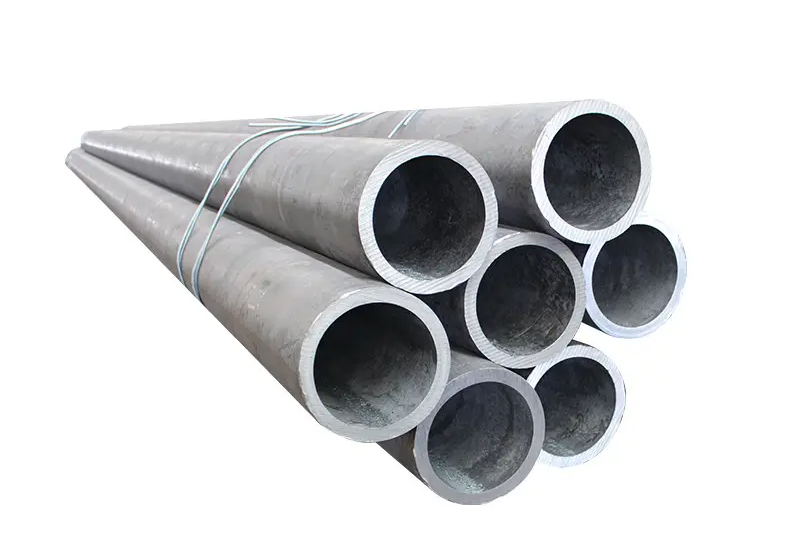ASTM A556 Alloy Steel Pipe

ASTM A556 Alloy Steel Pipe
Introduction
ASTM A556 is a standard specification for seamless cold-drawn carbon steel feedwater heater tubes. These tubes are designed for use in high-pressure and high-temperature applications, particularly in feedwater heaters. ASTM A556 specifies the requirements for two grades of seamless cold-drawn carbon steel tubes: Grade B2 and Grade C2.
Key Grades and Chemical Composition
ASTM A556 includes two main grades, each with specific chemical compositions to meet the needs of high-pressure and high-temperature environments.
Chemical Composition
Below are the chemical compositions for the grades specified under ASTM A556.
Grade B2
- Carbon (C): 0.18 – 0.24%
- Manganese (Mn): 0.27 – 0.93%
- Phosphorus (P): ≤ 0.035%
- Sulfur (S): ≤ 0.035%
- Silicon (Si): 0.10 – 0.35%
Grade C2
- Carbon (C): 0.10 – 0.20%
- Manganese (Mn): 0.30 – 1.06%
- Phosphorus (P): ≤ 0.035%
- Sulfur (S): ≤ 0.035%
- Silicon (Si): 0.10 – 0.35%
Mechanical Properties
The mechanical properties of ASTM A556 pipes depend on the grade and heat treatment applied. Here are typical properties for the specified grades:
Grade B2
- Tensile Strength: ≥ 415 MPa (60,000 psi)
- Yield Strength: ≥ 240 MPa (35,000 psi)
- Elongation: ≥ 30% in 2 inches (50.8 mm)
Grade C2
- Tensile Strength: ≥ 380 MPa (55,000 psi)
- Yield Strength: ≥ 205 MPa (30,000 psi)
- Elongation: ≥ 30% in 2 inches (50.8 mm)
Manufacturing Process
Seamless Cold-Drawn Process
ASTM A556 tubes are manufactured using the seamless cold-drawn process, which includes the following steps:
- Piercing: A solid billet is pierced to create a hollow shell.
- Cold Drawing: The hollow shell is drawn over a mandrel to achieve the desired dimensions and surface finish.
- Annealing: The tube undergoes heat treatment to relieve stresses and improve ductility.
- Straightening: The tube is straightened to ensure it meets dimensional tolerances.
- Cutting: The tube is cut to the required length.
Heat Treatment
Heat treatment is crucial to achieve the required mechanical properties:
- Annealing: Heating the tube to a high temperature followed by slow cooling to soften the material and relieve internal stresses.
Testing Requirements
ASTM A556 specifies several tests to ensure tube quality and performance:
- Tensile Test: Measures tensile strength, yield strength, and elongation.
- Flattening Test: Ensures the tube’s ability to resist flattening without cracking.
- Flaring Test: Ensures the tube can be flared without cracking.
- Hardness Test: Ensures the material meets specified hardness levels.
- Hydrostatic Test: Ensures the tube can withstand internal pressure without leaking.
- Non-Destructive Electric Test: Detects any defects in the tube material.
Applications
ASTM A556 tubes are used in high-pressure and high-temperature environments, including:
- Power Generation: Feedwater heater tubes in power plants.
- Petrochemical Industry: Heat exchanger tubes.
- Refineries: Tubing in high-pressure systems.
- General Engineering: Applications requiring high strength and thermal stability.
Advantages and Limitations
Advantages
- High-Temperature Performance: Suitable for applications involving high temperatures.
- Strength: High mechanical strength suitable for demanding applications.
- Dimensional Accuracy: Cold-drawn process ensures precise dimensions.
- Seamless Construction: Provides better pressure ratings and reliability.
Limitations
- Cost: Higher cost compared to welded tubes due to the seamless manufacturing process.
- Complex Manufacturing: Requires precise control over chemical composition and heat treatment.
- Availability: Specific grades and sizes may have longer lead times.
Conclusion
ASTM A556 seamless cold-drawn carbon steel tubes are essential for applications requiring high strength, high-temperature stability, and precision. Their superior mechanical properties, combined with rigorous manufacturing and testing processes, ensure they meet the demanding requirements of various industries. Understanding the detailed specifications, grades, and applications of ASTM A556 tubes helps engineers and designers select the right materials for their projects, ensuring safety and efficiency in challenging environments.







